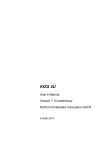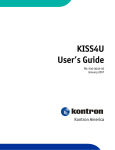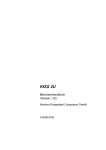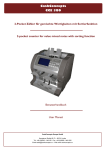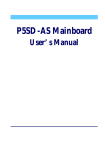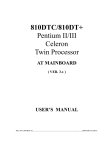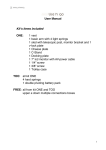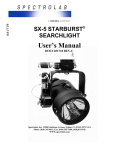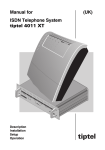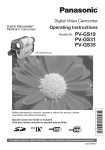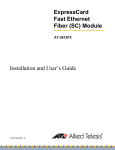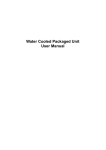Download User`s Manual Version: preliminary 0.98 Kontron Embedded
Transcript
KISS User’s Manual Version: preliminary 0.98 Kontron Embedded Computers GmbH 0-0096-3077 Contents Contents Introduction.......................................................................................................... 3 Symbols used in this Manual ................................................................................. 4 Important Instructions ........................................................................................ 5 Note on the Warranty ............................................................................................ 5 Exclusion of Accident Liability Obligation .............................................................. 5 Liability Limitation / Exemption from the Warranty Obligation ............................... 5 Safety Instructions .............................................................................................. 6 Operation of Laser Source Devices....................................................................... 8 Electrostatic Discharge (ESD) ............................................................................... 8 Grounding Methods .......................................................................................... 9 Instructions for the Lithium Battery ........................................................................ 9 FCC Statement.................................................................................................... 10 Electromagnetic Compatibility ............................................................................. 10 Scope of Delivery .............................................................................................. 11 Type Label and Product Identification ................................................................. 11 Product Description .......................................................................................... 12 Front Side ............................................................................................................ 18 Operating Elements ........................................................................................ 20 Interfaces on the Front Side............................................................................ 21 LED Indicators ................................................................................................ 21 Front Access Door .......................................................................................... 22 Filter Mat Holder ............................................................................................. 22 External Accessible Drive Bays....................................................................... 22 External Accessible Slim-Line or Internal 3.5“ Drive Bay (Option) ................. 22 Rear Panel........................................................................................................... 23 Interfaces on the Rear Side ............................................................................ 25 Power Supply Unit .......................................................................................... 26 Fan Slide-In Module and Temperature Sensors ............................................. 27 Side View............................................................................................................. 27 Integrated Motherboard / SBC-board .................................................................. 28 Backplane (for Configuration with SBC-Board)............................................... 29 Assembly, Disassembly.................................................................................... 32 Attaching the Rubber Feet................................................................................... 32 Removing the Drive Locking Screws ................................................................... 32 KISS - User’s Manual 1 Contents Accessing Internal Components ..........................................................................33 Installing/Removing the Expansion Cards.......................................................33 Instruction for Installation in a 19” Cabinet...........................................................37 Power Cord Connection.......................................................................................39 Operating System and Hardware Components Drivers .......................................40 Maintenance and Prevention ............................................................................41 Replacing the System’s Fans...............................................................................42 Cleaning the Filter Mat.........................................................................................45 Replacing the Lithium Battery ..............................................................................47 Slide Rails (Option)............................................................................................48 Main Specifications ...........................................................................................49 Electrical Specifications .......................................................................................50 Mechanical Specifications....................................................................................50 Environmental Specifications ...............................................................................51 CE-Directives and Standards...............................................................................52 Standard Interfaces – Pin Assignments ..........................................................53 COM1 / COM2 (RS232) .......................................................................................53 Parallel Port .........................................................................................................54 Technical Support..............................................................................................55 Returning Defective Merchandise ........................................................................56 2 KISS - User’s Manual Introduction Introduction Kontron Embedded Computers would like to point out that the information contained in this manual may be subject to technical alteration, particularly as a result of the constant upgrading of Kontron Embedded Computers products. The attached documentation does not entail any guarantee on the part of Kontron Embedded Computers with respect to technical processes described in the manual or any product characteristics set out in the manual. Kontron Embedded Computers does not accept any liability for any printing errors or other inaccuracies in the manual unless it can be proven that Kontron Embedded Computers is aware of such errors or inaccuracies or that Kontron Embedded Computers is unaware of these as a result of gross negligence and Kontron Embedded Computers has failed to eliminate these errors or inaccuracies for this reason. Kontron Embedded Computers expressly informs the user that this manual only contains a general description of technical processes and instructions which may not be applicable in every individual case. In cases of doubt, please contact Kontron Embedded Computers. This manual is protected by copyright. All rights are reserved by Kontron Embedded Computers. Copies of all or part of this manual or translations into a different language may only be made with the prior written consent of Kontron Embedded Computers. Kontron Embedded Computers points out that the information contained in this manual is constantly being updated in line with the technical alterations and improvements made by Kontron Embedded Computers to the products and thus this manual only reflects the technical status of the products by Kontron Embedded Computers at the time of printing. © 2004 by Kontron Embedded Computers Printing and duplication, even of sections, is only permissible with the express approval of Kontron Embedded Computers GmbH Oskar-von-Miller-Str. 1 85385 Eching near Munich Germany KISS - User’s Manual 3 Introduction Symbols used in this Manual Symbol Meaning This symbol indicates the danger of injury to the user or the risk of damage to the product if the corresponding warning notices are not observed. This symbol indicates that the product or parts thereof may be damaged if the corresponding warning notices are not observed. This symbol indicates general information about the product and the user manual. This symbol indicates detail information about the specific product configuration. This symbol precedes helpful hints and tips for daily use. 4 KISS - User’s Manual Important Instructions Important Instructions This chapter contains instructions which must be observed when using your KISS-Platform. The manufacturer’s instructions provide useful information on your KISSPlatform. Note on the Warranty Due to their limited service life, parts which by their nature are subject to a particularly high degree of wear (wearing parts) are excluded from the guarantee beyond that provided by law. This applies, for example, batteries. Exclusion of Accident Liability Obligation Kontron Embedded Computers shall be exempted from the statutory accident liability obligation if the user fails to observe the safety instructions. Liability Limitation / Exemption from the Warranty Obligation In the event of damage to the device caused by failure to observe the hints in this manual and eventually on the device (especially the safety instructions), Kontron Embedded Computers shall not be required to honor the warranty even during the warranty period and shall be exempted from the statutory accident liability obligation. KISS - User’s Manual 5 Safety Instructions Safety Instructions Please read this section carefully and observe the instructions for your own safety and correct use of the device. The chapter also contains information on approval and interference suppression of your system. Observe the warnings and instructions on the device and in the manual. The KISS system is built and tested by Kontron Embedded Computers in accordance with EN60950/VDE0805 and left the company in a perfectly safe condition. In order to maintain this condition and ensure safe operation, the user must observe the instructions and warnings contained in this manual. Kontron Embedded Computers can only guarantee the safety, reliability and performance of the device if all of the following safety instructions are observed. Caution: Energy hazards > 240 VA are present inside the chassis!!! Only qualified personnel and/or by Kontron Embedded Computer authorized persons are permitted to work inside the system or handling expansion cards!!!! q Maintenance or repair on the open device may only be carried out by qualified personnel authorized by Kontron Embedded Computers familiar with the associated dangers. q The device may only be opened for the installation and removal of AGP/ISA/PCI cards in accordance with the description in this manual. These procedures have to be carried-out only by qualified specialist personnel. q If extensions are made to the device the legal stipulations and the device specifications must be observed. q The device must be switched off and the power cord disconnected from the power source before insertion of any AGP/PCI/ISA cards. q The unit is not completely disconnected from the main power source by turning off with the power ATX-power button. The unit is complete disconnected from the main power source, only when the power cord is disconnected either from the power source or from the unit. Therefore the power cord and its connectors must always remain easily accessible. 6 KISS - User’s Manual Safety Instructions q The device must be used in accordance with the instructions for use. q The electrical installations in the room must correspond to the requirements of the respective regulations. q Take care that there are no cables, particularly power cables, in areas where persons can trip over them. q Do not use a main connection in sockets shared by a number of other power consumers. Do not use an extension cable. q Only use the main cable supplied. q Do not place the device near heat sources or in a damp location. Make sure the device has adequate ventilation. q Only devices and components which fulfill the requirements of an SELV circuit (security low voltage output) in accordance with EN60950 may be connected to the interfaces of the system. q All plugs on the connection cables must be screwed or locked to the housing. q The device is designed to be used: · rack and desktop version in horizontal position and · tower version in vertical position. q Only approved original accessories by Kontron Embedded Computers have to be used. q It must be assumed that safe operation is no longer possible, – if the device has visible damage or – if the device no longer functions. In these cases the device must be shut down and secured against unintentional operation. KISS - User’s Manual 7 Safety Instructions Operation of Laser Source Devices Fig. 1: Warning about laser radiation The optional CD ROM- and DVD ROM-drives contain light-emitting diodes (classified in accordance with IEC 825-1:1993: LASER CLASS 1) and, therefore, must not be opened. If the enclosure of such a drive is opened, invisible laser radiation is emitted. Do not allow yourself to be exposed to this radiation. Laser system meet the code of Federal Regulations 21 CFR,1040 for USA and Canadian Radiation Emitting Devices Act, REDR C 1370. Electrostatic Discharge (ESD) A sudden discharge of electrostatic electricity can destroy static-sensitive devices or micro-circuitry. Proper packaging and grounding techniques are necessary precautions to prevent damage. Always take the following precautions: 1. Transport boards in static-safe containers such as boxes or bags. 2. Keep electrostatic sensitive parts in their containers until they arrive at staticfree stations. 3. Always be properly grounded when touching a sensitive board, component, or assembly. 4. Store electrostatic-sensitive boards in protective packaging or on conductive foam. 8 KISS - User’s Manual Safety Instructions Grounding Methods Guard against electrostatic damage at the device by following these steps: 1. Cover workstations with approved anti-static material. Provide a wrist strap connected to a work surface and properly grounded tools and equipment. 2. Use anti-static mats, heel straps, or air ionizes to give added protection. 3. Handle electrostatic-sensitive components, boards, and assemblies by the case or the PCB edge. 4. Avoid contact with pins, leads, or circuitry. 5. Turn off power and input signals before inserting and removing connectors or test equipment. 6. Keep work area free of non-conductive materials such as ordinary plastic assembly aids and Styrofoam. 7. Use field service tools, such as cutters, screwdrivers, and vacuums that are conductive. 8. Always place drives and boards PCB-assembly-side down on the foam. Instructions for the Lithium Battery The implemented mainbord or SBC-board is equipped with a Lithium battery. For the replacing of this battery please observe the instructions described in the chapter “Replacing the Lithium Battery ”. Warning Danger of explosion when replacing with wrong type of battery. Replace only with the same or equivalent type recommended by the manufacturer. Do not dispose of lithium batteries in general trash collection. Dispose of the battery according to the local regulations dealing with the disposal of these special materials, (e.g. to the collecting points for dispose of batteries). KISS - User’s Manual 9 Safety Instructions FCC Statement This equipment has been tested and found to comply with the limits for a Class A digital device, pursuant to Part 15 of the FCC Rules. These limits are designed to provide reasonable protection against harmful interference when the equipment is operated in commercial environment. This equipment generates, uses, and can radiate radio frequency energy and, if not installed and used in accordance with the instruction manual, may cause harmful interference to radio communications. Operation of this equipment in residential area is likely to cause harmful interference in which case the user will be required to correct the interference at his own expense. Electromagnetic Compatibility This product has been designed for industrial, commercial and office use, including small business use. The most recent version of the EMC guidelines (EMC Rules 89/336/EWG) and/or the German EMC laws apply. If the user modifies and/or adds to the equipment (e.g. installation of add-on cards), the prerequisites for the CE conformity declaration (safety requirements) may no longer apply. 10 KISS - User’s Manual Scope of Delivery Scope of Delivery q KISS-Platform (corresponding the ordered configuration) q This user’s manual q Motherboard or SBC-board – User’s Manual q CD-ROM with drivers for the installation of the SBC-board q Two keys for the front door lock q Power cord (for AC power supply units only) Type Label and Product Identification The type label of the KISS-Platform is placed on the right side of the unit. Product designation on the type label Product identification KISS_ATX MB-A KISS with 886LCD Motherboard KISS_PCI 951-B KISS with PCI-951 SBC-board (Single Board Computer) KISS_PCI 953-B KISS with PCI-953 SBC-board (Single Board Computer) KISS_EPCI-B KISS with ePCI 200 SBC-board (Single Board Computer) KISS_ATX Dual Xeon-C KISS with Dual Xeon Motherboard KISS - User’s Manual 11 Product Description Product Description KISS is a scalable 4U (19") Platform, that can be alternatively equipped with a motherboard or a single board computer (SBC)-board. The KISS-Platform hardware can be flexibly configured corresponding to the customized requirements. In addition, the sturdy design with excellent mechanical stability, provides the demanding characteristics required for a computer, that is suitably for using in harsh industrial environment. The KISS-Platform is designed to be installed in 19“ racks. It is also offered as tower- and desktop version. Versions of the KISS-Platform: Fig. 2: Rackmount version with Fig. 3: Tower version with closed access door closed access door Fig. 2a: Rackmaunt version with opened access door 12 Fig. 3a: Tower- version with opened access door Fig. 4: Desktop version with closed access door Fig. 4a: Desktop- version with opened access door KISS - User’s Manual Product Description The system is equipped with five front accessible drive bays (two 3.5” and three 5.25” bays). The operating elements of the KISS-Platform are located behind the front access door and consist of the “ATX-power button” and the “Reset-button” for the standard configuration. The LED-indicators are located on the front side; for the standard version these are composed of the “power-LED” and “hard disk activity-LED”. The system fans (2 off) are installed at the front side of the unit. These are attached to the system by means of a fan slide-in module. The fan slide-in module simplifies the installation and removal of these components, also during operation. The washable filter mat, which protects your system against dust and dirt is located behind the air grilles of the front access door. The outside accessible filter mat is changeable while the KISS-Platform is powered-up. The type label is attached to the right side of the unit. Fig 5: KISS-Platform When switching on the system, make sure that the air intake and exhaust openings are not obstructed by objects. For rack and desktop version only: Before the system is put for the first time into operation (before mounting / installation into an industrial cabinet), you have to open the unit as described in the "Accessing Internal Components" section and to remove the drive locking screws (fig. 6, 6a, 7, 7a pos. 14). KISS - User’s Manual 13 Product Description 15 14 13 12 9 1 11 2 10 3 4 5 6 7 8 9 Fig 6: KISS-Platform, opened rackmount version [with motherboard (KISS_ATX MB-A)] Legend for figures: 6 and 6a 1 Power supply unit 2 Motherboard (example) 3 Exhaust openings on the rear side 4 Free AGP-slot (available only in KISS_ATX MB-A) 5 Free expansion slots 6 Cards holder 7 Card guides 8 Fan slide-in module with captive knurled screw 9 19” rack mountable bracket with handle (not available for tower and desktop version) 14 10 Guide openings for the cover 11 Front access door 12 Drive cage for 3x 5.25“ drive bay and 1x 3.5“ internal drive bay 13 Drive bracket for 2x 3.5“ drive bay 14 Drive locking screws 15 Fastening screw for the card holder 16 External interfaces of the motherboard 17 Grounding stud 18 Expansion card slots KISS - User’s Manual Product Description 9 12 10 11 8 9 13 14 15 7 6 2 4 5 1 3 17 16 18 Fig 6a: KISS-Platform, opened rackmount version [with motherboard (KISS_ATX MB-A)] When switching on the system, make sure that the air intake and exhaust openings are not obstructed by objects. For rack and desktop version only: Before the system is put for the first time into operation (before mounting / installation into an industrial cabinet), you have to open the unit as described in the "Accessing Internal Components" section and to remove the drive locking screws (Fig. 6, 6a, 7, 7a pos. 14). KISS - User’s Manual 15 Product Description 13 14 12 11 1 10 2 3 9 4 5 6 7 8 Fig. 7: KISS-Platform, opened desktop version [with SBC-board (KISS_PCI 953-B)] Legend for figures: 7 and 7a: 1 Power supply unit 2 Backplane (example) 3 Free expansion PCI-slots 4 Exhaust openings on the rear side 5 Single Board Computer (example) 6 Cards holder 7 Card guides 8 Fan slide-in module with captive knurled screw 9 Guide openings for the cover 10 Front access door 16 11 Drive cage for 3x 5.25“ drive bay and 1x 3.5“ internal drive bay 12 Drive bracket for 2x 3.5“ drive 13 Fastining screw for the card holder 14 Drive locking screws 15 External interfaces of the SBC-board 16 Additional external interfaces 17 Grounding stud 18 Expansion card slots KISS - User’s Manual Product Description 11 10 9 8 12 14 13 7 6 2 5 3 1 4 16 17 18 15 Fig. 7a: KISS-Platform, opened desktop version [with SBC-board (KISS_PCI 953-B)] When switching on the system, make sure that the air intake and exhaust openings are not obstructed by objects. For rack and desktop version only: Before the system is put for the first time into operation (before mounting / installation into an industrial cabinet), you have to open the unit as described in the "Accessing Internal Components" section and to remove the drive locking screws (Fig. 6, 6a, 7, 7a pos. 14). KISS - User’s Manual 17 Product Description Front Side The system is available in rackmount version. 1 1 2 3 4 Fig. 8: Front side (rackmount version) with closed front access door 1 19” rack mountable bracket with handle (not available for tower version) 2 Cut-out for LED indicators 3 Air grilles 4 Front access door with lock mechanism You can adapt your system to a desktop unit by removing the two 19” rack mountable bracket with handle (one off on each side). 2 1 3 4 3 1 Chassis of the KISS-Platform 2 19” rack mountable bracket with handle 3 Holes for mounting in rack cabinets 4 Handles 5 Screws for fastening the 19” rack mountable bracket 5 Fig. 9: 19” rack mountable bracket with fastening screws The KISS tower version is delivered without 19” rack mountable bracket. 18 KISS - User’s Manual Product Description The operating elements (ATX-power button and reset button), the USB interfaces and the integrated drives are located at the front side of the KISS-Platform, behind the front access door. 1 2 3 4 5 10 6 9 8 1 7 Fig. 10: Front side (rackmount version) with opened front access door 1 Buffer for the front access door 2 Bracket with knurled screw for the air filter mat 3 LED indicators 4 Slot for the locking mechanism 5 2x 3.5” drive bay (shown with one equipped FDD) 6 3x 5.25” external accessible drive bay (shown with one equipped DVD-drive) 7 1x internal 3,5“- or 1x external Slimdrive bay (not available in tower version) 8 Reset-button 9 ATX-power button 10 2x USB interface KISS - User’s Manual 19 Product Description Operating Elements ATX-power button Press this button to turn the system on or off. Reset-button If your system no longer reacts, you have to restart the KISSPlatform. Press the reset button to restart your system. When you reset, all data in the main memory are erased. The system restarts without having to turn the computer off and back on again. Even if you turn off the system with the ATX-power button, there is still a standby-voltage of 5 V on the SBCboard/motherboard. The system is not completely disconnected from the main power source by turning off the with the ATX-power button. The unit is complete disconnected from the main power source, only when: q the power cord is disconnected either from the power source or the unit (for KISS system with power supply unit (PSU) without PSU On/Off power switch). or q the On/Off power switch of the power supply unit is switched “Off” (for KISS systems with power supply unit (PSU) with PSU On/Off power switch) Therefore the power cord and its connectors must always remain easily accessible. 20 KISS - User’s Manual Product Description Interfaces on the Front Side USB Interfaces KISS is equipped with two USB interfaces at the front side. These connectors allow you to connect different USB-compatible devices to the KISS-Platform. Integrated Board Dual Xeon-Board Motherboard LCD 886 Motherboard PCI-951 SBC-board PCI-953 SBC-board EPCI-200 SBC-board Supports USB1.1 Supports USB2.0 ) ) ) ) ) ) ) ) ) ! Please observe that the KISS-Platform equipped with ePCI-200 SBC-board supports USB1.1 only. LED Indicators Following LED indicators at the left front side of the KISS-Platform: LED indicators Power LED (green) Lights up green if the system switched on by pressing the “ATX-power button”. Prerequisite: The system must be attached by means of the power cord to an appropriate power source. The power switch of the PSU located on the rear side of the unit must be set to “On” (only for systems with PSU equipped with PSU switch). HDD Activity LED (orange) Indicates hard disk activity. Do not press the disk eject while the disk drive LED is lit or blinking. KISS - User’s Manual 21 Product Description Front Access Door You can protect the drives and operating elements at the front side of the KISS-Platform from unauthorized use, by means of the front access door equipped with a securing lock mechanism (only with no attached USB devices). The key should be kept somewhere where it is not accessible to unauthorized persons. The KISS-Platform comes equipped with two keys. If the keys get lost or damaged, then the front access door can be opened only by Kontron Embedded Computers service personnel. Filter Mat Holder The filter mat holder is located behind the air grilles of the front access door. The filter mat is inserted in the air filter holder. The filter mat protects your system against dust and dirt. The filter mat is changeable while the system is poweredup. (see “Cleaning the Filter Mat“ section). External Accessible Drive Bays The KISS system can be equipped with up to five external accessible drives. Following drive bays are available: q 3x 5.25“ drive bay (horizontal position) q 2x 3.5” drive bay (vertical position) External Accessible Slim-Line or Internal 3.5“ Drive Bay (Option) The KISS desktop and rackmount version can be optionally equipped with: q 1x internal, not visible from the outside, 3.5“ drive bracket in horizontal position (for IDE/SCSI/SATA hard disk drive) or q 1x external accessible slim-drive bay in horizontal position. This option is not available in systems configured as tower version. 22 KISS - User’s Manual Product Description Rear Panel Depending on the ordered KISS-Platform configuration, at the rear side are situated the external interfaces of the integrated motherboard or SBC-board, the additional interfaces (only in system configuration with SBC-board), the power supply unit and the air exhaust openings. The configuration respectively the number of the KISS-Platform interfaces may vary depending on the device equipment. 6 7 8 9 1 2 3 4 10 5 Fig. 11: KISS_ATX MB-A – rear side (always with 300 W PSU) 6 7 8 9 1 3 2 10 5 Fig. 11a: KISS_ATX_ Dual Xeon-C – rear side (always with 450 W PSU) KISS - User’s Manual 23 Product Description 6 7 8 9 1 11 13 3 4 5 14 12 10 Fig. 11b: KISS with SBC-board (example) – rear side (always with 350 W PSU) Legend for figures: 11, 11a, and 11b: 1 Fan of the PSU 2 On/Off switch of the PSU (depending on the integrated PSU) 3 AC-power plug 4 AC-socket for monitor (depending on the integrated PSU) 5 32 bit or 64 bit free expansion card slots (depending on the integrated board) 6 Grounding stud 7 Captive knurled screws to secure the cover 8 Device cover 9 Air exhaust openings 24 10 Interfaces of the SBC-board or of the motherboards (depending on the system configuration) 11 Additional serial interface (COM2) (only in configuration with SBC-board) 12 additional parallel interface (LPT) (only in configuration with SBC-board) 13 Additional serial interface (COM1) (only in configuration with SBC-board) 14 Two additional USB interfaces (only in configuration with SBC-board) KISS - User’s Manual Product Description Interfaces on the Rear Side The configuration respectively the number of the KISS-Platform interfaces may vary depending on the device equipment. External Interfaces of the integrated Motherboard The external interfaces of the motherboard can be different, depending on the integrated motherboard. Refer to the information and technical data in the supplied user manual of the motherboard. External Interfaces of the integrated SBC-board The external interfaces of the SBC-board can be different, depending on the integrated SBC-board. Refer to the information and technical data in the supplied user manual of the SBC-board. Additional Interfaces in Configuration with SBC-board Serial Interfaces (COM1, COM2) These connections are available as 9-pin D-SUB plug and allow you to connect serial peripherals. These additional interfaces are configured as RS232. Refer to the information and technical data in the supplied user manual of the SBC-board. KISS - User’s Manual 25 Product Description Parallel Interface Connector LPT1 This connector is available as a 25-pin D SUB socket. The parallel interface LPT1 supports different modes: SPP, EPP and ECP. It is used for the connection of an external printer and can also be used for other external devices, which can be connected via a parallel port. Nonetheless, depending on the device, the manufacturer’s instructions must be observed and the necessary software driver installed. USB Interfaces KISS is equipped with two USB interfaces at the rear side. These connectors allow you to connect different USB-compatible devices to the KISS-Platform. Integrated Board Dual Xeon-Board Motherboard LCD 886 Motherboard PCI-951 SBC-board PCI-953 SBC-board EPCI-200 SBC-Board Supports USB1.1 Supports USB2.0 ) ) ) ) ) ) ) ) ) ! Please observe that the KISS-Platform equipped with ePCI-200 SBC-board supports USB1.1 only. Power Supply Unit The power supply unit (PSU) is placed on the rear side of the unit. The implemented PSU depends on the ordered system configuration (integrated motherboard respectively SBC-board). For information about the integrated power supply unit (PSU) and the supply voltage of your system, refer to the type label attached on the right side of the unit. Upon request, your system can be equipped also with a DC power supply. 26 KISS - User’s Manual Product Description Fan Slide-In Module and Temperature Sensors The two fans of the system are firmly mounted in a user friendly, exchangeable fan slide-in module (hot swap). The fan slide-in module is installed in the fan case located at the front side of the system. The systems fans are temperature-controlled via the temperature sensors which are built in the system. Thus sufficient airflow is ensured for an optimal, active cooling of the system. The operation of the KISS-Platform is permitted only with a functional fan slide-in module (refer to the “Replacing the System’s Fans” section). Defective components may be replaced only by Kontron original spare parts. q part number of the fan slide-in module: 0-0084-3604 The temperature conditions of the system (dependent on the ambient temperature and the system load) are acquired by two temperature sensors. One of the temperature sensors is attached in the rear range of the system (air exhaust openings) and the second one is attached laterally, in the middle range. Side View Four M4 metric tapped holes are available at the left and right side of the unit. These can be used in order to attach slide rails (not included in the scope of delivery) to the KISS-Platform (for system installation into a 19” industrial cabinet). Refer to the “Slide Rails (Option)” chapter. 2 1 Fig. 12: Tapped M4 metric holes to attach a telescope rail 1 Side view of the KISS-Platform KISS - User’s Manual 2 4x tapped M4 metric holes (on both sides) 27 Product Description Integrated Motherboard / SBC-board Depending on the ordered system configuration, your KISS-Platform accommodates either a motherboard or a SBC-board. System identification Integrated Board Board Type KISS_ATX MB-A 886LCD Motherboard KISS_ATX Dual Xeon-C Dual-Xeon Motherboard KISS_PCI 951-B PCI-951 Single Board Computer KISS_PCI 953-B PCI-953 Single Board Computer KISS_EPCI-B ePCI-200 Single Board Computer Refer to the information and technical data in the supplied user manual of the motherboard or SBC-board. Depending on the ordered KISS hardware configuration you can expand your system with extension cards with full or half size length. To expand your system with additional cards, please observe the power consumption specification specified in the “Main Specifications” chapter and that every additional card does not exceed 25 W power consumption. 28 KISS - User’s Manual Product Description Backplane (for Configuration with SBC-Board) To expand your system with additional cards, please observe the power consumption specification specified in the “Main Specifications” chapter and that every additional card does not exceed 25 W power consumption. 1 Maximal supported Bus speeds 2 3 1 1x PICMG 1.2 CPU-slot 2 4x 64 bit @ 66 MHz PCIslot, 3.3 V keying 3 2x 64 bit @ 133 MHz PCISteckplatz, 3,3 V Keying 4 4x 32 bit @ 33MHz PCISteckplatz, 5 V Keying 4 Fig. 13: Backplane (for system configuration with ePCI-200 SBC-board) KISS - User’s Manual 29 Product Description 1 3 1 1 2x 64 bit PICMG 1.0 CPU-slot 2 1x 16 bit ISA- / 64 bit PCIshared slot 3 12x 64 bit PCI-slot 2 Fig. 13a: Backplane (for system configuration with PCI-953 SBC-board) 1 2 1 2x 32 bit PICMG 1.0 CPU-slot 2 5x 16 bit ISA-slot 3 7x 32 bit PCI-slot 3 Fig. 13b: Backplane (for system configuration with PCI-951 SBC-board) 30 KISS - User’s Manual Product Description 1 2 4 1 2x 32 bit PICMG 1.0 CPU-slot 2 11x 32 bit PCI-slot 3 1x 16 bit ISA-slot 4 1x 16 bit ISA- / 32 bit PCIshared slot (if the left PICMG CPU-slot is not fitted with a SBC-card) 3 Fig. 13c: Backplane (for system configuration with PCI-951 SBC-board) KISS - User’s Manual 31 Assembly, Disassembly Assembly, Disassembly Attaching the Rubber Feet The rubber feet can be used for the desktop version of the system. Please follow these steps to attach the rubber feet to the bottom side of the chassis: Before attempting to mount the rubber feet, the system must be powered-down and the power cord has to be disconnected from the power source. 1. Make sure that all cards are secured into the unit and that the system cover is installed and secured. 2. Turn the system upside down. 3. Remove the protect foil from the delivered self adhesive rubber feet. 4. Attach the self adhesive rubber feet to the bottom side of the chassis. Removing the Drive Locking Screws Before you start-up the system (only for rackmount- and desktop version) for the first time (before mounting/mounting into an industrial cabinet) open the system as described in the “Accessing Internal Components” section and remove the drive locking screws. 2 1 1 Drive cage 2 Drive locking screws Fig. 14: KISS-Drive cage with drive locking screws 32 KISS - User’s Manual Assembly, Disassembly Accessing Internal Components This section contains important information that you must read before accessing the internal components. You must follow these procedures properly when handling any boards or replacing the fan slide in module. Installing/Removing the Expansion Cards Please consider following instruction when you install (or remove) expansion cards. Caution: Energy hazards > 240 VA are present inside the chassis!!! Only qualified personnel and/or by Kontron Embedded Computer authorized persons are permitted to work inside the system or handling expansion cards!!!! The installation and removal of PCI/ISA/AGP cards have to be carried-out only by qualified specialist personnel in accordance with the description in this manual. Before removing the cover to gain access to the internal components, the system must be powered-down and the power cord has to be disconnected from the power source. To expand your system with additional cards, please observe the power consumption specification specified in the “Main Specifications” chapter and that each additional card does not exceed 25 W power consumption. Please observe the safety instruction for handling assemblies with static sensitive device. Failure to take heed of this warning instruction can result in damage to the device. Please consult the documentation provided by the manufacturer of the expansion card for instructions before attempting to install/remove an expansion card into/from the KISS-Platform. KISS - User’s Manual 33 Assembly, Disassembly To install or remove an expansion card, perform the following steps: 1. Turn off all power sources. Disconnect the power cord from power source. 2. Loosen the captive knurled screws on the rear side of the unit that secure the cover. Fig. 15: Loosen the captive knurled screws 3. Lift the cover away. Fig. 16: Removing the device cover Fig. 17: KISS-Platform without cover 34 KISS - User’s Manual Assembly, Disassembly 4. To remove the card holder loosen the screw of the card holder (1). Slide the card hold-down bracket to right (2), to pull it out from the two laterally located bolts. Lift the card hold-down bracket away (3). Retain the card hold-down bracket and the screw for later use. 1 3 4 2 Fig. 18: Removing the fastening screw the card hold-down bracket 1 2 Fig. 19: Bolts and fastening point for the card hold-down bracket 5 Legend for figures: 18, 19 and 20: 1 Bolts for the card hold-down bracket 2 Threaded bolt 3 Locating holes 4 PCB holder 5 Hole for the fastening screw 3 4 Fig. 20: card hold-down bracket KISS - User’s Manual 35 Assembly, Disassembly 5. Put/pull the expansion card into/or out from the expansion card slot of the backplane/motherboard and fasten the mounting bracket of the expansion card/filler bracket to the rear slot of the device. 6. Reinstall the card holder and secure it using the retaining screw (see Fig. 17). 7. The PCP holder has to be installed into the appropriate hole of the card holddown bracket by means of the provided screw, if necessary. Fix the upper edge of the expansion card (especially for full-length card) into the slot of the PCB holder (height adjustable). Thus the card is firmly kept in place during high mechanical load (shock and vibrations). 8. Close the KISS-Platform and secure the cover with the captive knurled screws. Please consult the documentation provided by the manufacturer of the expansion card for instructions before attempting to install/remove an expansion card into/from the system. 36 KISS - User’s Manual Assembly, Disassembly Instruction for Installation in a 19” Cabinet Expansion card installation should be performed before installing the KISS-system into an industrial cabinet or into a control panel. Refer to the “Accessing Internal Components” section. Before closing the industrial cabinet, you have to connect the peripheral devices to the system interfaces. Refer to the “Interfaces on the Rear Side” subsection for the detailed description of the interfaces. If you mount the KISS-system into an industrial cabinet, it is advisable to use two people for the mounting, because the system weighs approx. 20 kg (approx. 44 lbs.). Important Instructions! The KISS-Platform has to be installed only by trained and qualified personal. The KISS-Platform should be installed into a 19”-industrial cabinet with mounting rails. Check the load capacity of the mounting rails [the unit may weigh up to 20 kg (approx. 44 lbs.)]. Ensure there is sufficient air circulation around the device when installing the KISS-Platform. The openings for air intake and exhaust on the device must not be obstructed. Leave at least 5 cm (approx. 2”.) of free space in front and behind the unit to prevent the device from possibly overheating! KISS - User’s Manual 37 Assembly, Disassembly The 19" industrial cabinet must stand firmly in place. You can improve its stability by placing the components into it from the bottom up. Heavy components should be placed down below. If further stabilization is necessary, then bolt the 19" industrial cabinet to the floor or anchor it on the wall. The voltage feeds must not be overloaded. Adjust the cabling and the external overcharge protection to correspond with the electrical data indicated on the type label. The type label is located on right side of the unit. 38 KISS - User’s Manual Assembly, Disassembly Power Cord Connection The AC power plug is located on the rear side of the KISS-Platform. AC-power plug Fig. 21: AC-Power connection (KISS_ATX MB-A) AC power plug Fig. 22: AC-Power connection (KISS_ATX Dual Xeon-C) AC-power plug Fig. 23: AC-Power connection (KISS_PCI 951-/ 953-/ EPCI-B) KISS - User’s Manual 39 Assembly, Disassembly The voltage of the power source must agree with the voltage value on the type label. 1. Connect the supplied AC power cord into the system AC power plug (see fig. 21, 22 and 23). 2. Connect the other end of the AC power cord into a corresponding outlet. Use the power cord suitable for the power supply in your country. Do not remove or alter the grounding prong on the power cord. In situations where a two-slot receptacle is present, have it replaced with a properly grounded three-prong grounding type receptacle. Operating System and Hardware Components Drivers The KISS-system can optionally be supplied with or without a pre- installed operating system. If you have ordered your system with a pre- installed operating system, all drivers are installed, corresponding to the ordered computer configuration (optional hardware components). Your computer is fully functional, when you switch it on for the first time. If you have ordered your system without pre- installed operating system, you have to install the operating system and the corresponding drivers for the ordered computer configuration (optional hardware components). Consider the manufacturer specifications of the operating system and the integrated hardware components. 40 KISS - User’s Manual Maintenance and Prevention Maintenance and Prevention Kontron Embedded Computers systems require minimal maintenance and care to keep them operating correctly. q Occasionally wipe the system with a soft dry cloth. q You should only remove persistent dirt by use of a soft, slightly damp cloth (use only a mild detergent). q Clean the air filter mats regularly (refer to the “Cleaning the Filter Mat” section). KISS - User’s Manual 41 Maintenance and Prevention Replacing the System’s Fans The operation of the KISS-Platform is permitted only with a functional fan slide-in module. Defective components may be replaced only by Kontron original spare parts. q part number of the fan slide-in module: 0-0084-3604 Important Instructions! The fan slide-in module is changeable while the KISS-Platform is powered-up. This maintenance may only be carried out by qualified personnel familiar with the associated dangers. To replace fan slide-in module, proceed as follows: 1. Open the unit as described in the “Accessing Internal Components” section, step 2-3. Pull out the device cover only so far, to have access to the fan slidein module. 2. Loosen the captive knurled screw (Fig. 24, pos. 4). Use the handle (Fig. 24, 24a, pos. 2) of the fan slide-in module and pull it out from the fan case (Fig. 24c, pos. 9). 1 2 3 4 Fig. 24: KISS-Platform with fan slide-in module 42 KISS - User’s Manual Maintenance and Prevention nach oben heraus. 3 2 5 Fig. 24a: Side view of the fan slide-in module 3 5 6 Fig. 24b: Bottom view of the fan slide-in module Legend for figures: 24, 24a, 24b and 24c 1 Front access door of the system 2 Handle of the fan slide-in module 3 2x system fan (temperature controlled, independently controlled) 4 Captive knurled screw 5 Plug for fan control KISS - User’s Manual 6 Centering slot on the bottom side of the fan slide-in module 7 Socket in the fan case for fan control 8 Centering angle 9 Fan case 43 Maintenance and Prevention 1 7 4 8 9 Fig. 24c: Fan case of the KISS-Platform without fan slide-in module 3. Replace the fan slide-in module with a new functional module. Push the fan slide-in module carefully into the fan case socket connector, by aligning the centering angle (Fig. 24c, pos. 8) to the centering slot (Fig. 24b, pos. 6). 4. Secure the fan slide-in module with the captive knurled screw. 5. Close the KISS-Platform and secure the cover with the captive knurled screws. 44 KISS - User’s Manual Maintenance and Prevention Cleaning the Filter Mat The filter mat is inserted in the filter mat holder at the front side of the system. Cleaning frequency of the filter mat will depend on the operating environment. If the environment is extremely dusty, clean the filter mat more often. The filter mat can be changed even if the system is powered-up. 1 2 1 Filter mat holder 2 Fastening screw of the filter mat holder 3 Front access door 3 Fig. 25: Location of the filter mat To replace or clean the air filter mat, proceed as follows: 1. Open the front access door. 2. Loosen the knurled screw that secure the filter mat holder with the air filter mat to the chassis. 3. Pull out the filter mat holder into the marked direction. 4. Remove the dirty air filter mat. 5. To clean the filter mat: q Rinse in water (up to approx. 40°C; you may add mild-duty commercial detergent). q It is also possible to beat it out, vacuum it or blast it with warm compressed air. q If the filter is soiled with greasy dust, you should rinse it with warm water with degreaser added. Do not clean the filter mat with a piercing jet of water or wring it out. KISS - User’s Manual 45 Maintenance and Prevention 6. After cleaning and drying the filter mat, replace it into the filter mat holder, Replace the filter mat holder to the front side of the chassis (see Fig. 26, pos. 3 and Fig. 26a, pos. 4). 7. Tighten the screw to secure the filter mat holder to the chassis. When inserting the filter mat, ensure that the denser side of the mat is facing the fans. Defective components may be replaced only by Kontron original spare parts. q part number of the filter mat: 0-0084-2953 Legend for figures: 26, 26a and 26b: 1 2 1 Threaded M4 metric stud 2 Air intake openings 3 Centering holes for the filter mat holder 4 Locking tabs 5 Inserted filter mat 6 Fastening screw of the filter mat holder 7 Filter mat holder 3 Fig. 26: Location for filter mat holder 4 4 5 7 6 6 Fig. 26a: Filter mat holder with filter mat 46 Fig. 26b: Filter mat holder without filter mat KISS - User’s Manual Maintenance and Prevention Replacing the Lithium Battery The integrated motherboard or SBC-board of your system is equipped with a lithium battery. To replace the battery, please proceed as follows: 1. Open the unit as described in the “Installing/Removing the Expansion Cards” chapter (step 1-4). 2. If your system is expanded with expansion cards, please remove at first the cards and the corresponding data cables, to have access to the lithium battery. 3. Remove the battery by pressing outwards the ejector spring. 4. Place the new battery into the socket. 5. Make sure that you insert the battery the right way around. The plus pole must be on the top! 6. The lithium battery must be replaced with an identical battery or a battery type recommended by Kontron Embedded Computers. 7. Reinstall the removed expansion cards and reconnect the removed data cable. 8. Close the Unit as described in chapter “Installing/Removing the Expansion Cards” (step 5-8). Do not dispose of lithium batteries in general trash collection. Dispose of the battery according to the local regulations dealing with the disposal of these special materials, (e.g. to the collecting points for dispose of batteries). KISS - User’s Manual 47 Slide Rails (Option) Slide Rails (Option) Kontron offers slide rails for the installation of the KISS-Platform into a 19“ industrial cabinet. These can be ordered under: “Slide rails” - Set No.: 3-A260-0244. 3 2 1 Fig. 27: Attaching the inner side of the slide rail 4 3 1 Fig. 27a: Kiss-Plattform with slide rail Legend for figures: 27 and 27a: 1 Side view of the KISS-Platform 3 Slide rail inner part 2 4x M4x6 rounded head screw (per 4 each side of the unit) Slide rail outer part Please observe, that only the specified M4x6 screws may be used for the attachment of telescope rails to the KISS-Platform. 48 KISS - User’s Manual Main Specifications Main Specifications Processor KISS_ATX MB-A Intel® P4, 2.8 GHz or faster KISS_PCI 951-B Intel® P4, 2.8 GHz or faster KISS_PCI 953-B Intel® P4, 3.2 GHz KISS_EPCI-B Intel® P4, 2.8 GHz or faster KISS_ATX Dual Xeon-C Intel® Xeon, 3.06 GHz or faster Lithium-Battery Type: CR2032; 3.0 V; 0.22Ah; LIXING Drive bays at the front side & internal 3x 5.25”, outside accessible (horizontal position) 2x 3.5”, outside accessible (vertical position) Option (not available for tower version): 1x 3.5“ (internal) 1x Slim External Interfaces at the rear side for systems with SBC-board: Interfaces of the SBC-board, (refer to SBC User’s Manual) Additional interfaces: * 2x USB (1.1/2.0) 1x COM1 (configured as RS232) 1x COM2 (configured as RS232) 1x LPT1 for systems with motherboard: Interfaces of the motherboard, (refer to Motherboard User’s Manual) External Interfaces at the front side *2x USB (1.1/2.0) Operating elements at the front side 1x ATX-power button 1x Reset-button Operating element at the rear side 1x PSU switch LED-indicators at the front side 1x Power-LED 1x HDD activity-LED Expansion slots at the rear side AC-power plug / AC-outlet for monitor at the rear side KISS_ATX MB-A KISS_ATX Dual Xeon-C Up to maximal 12 free expansion slots The number and type of the free expansion slots depend on the integrated board, type of the board and the system‘s hardware configuration. AC Monitor KISS_ATX MB-A Connectors ) ) KISS_PCI 951-B ) ) KISS_PCI 953-B ) ) KISS_EPCI-B ) ) ) KISS_ATX Dual Xeon-C * KISS-system with ePCI200 SBC-board (KISS_EPCI-B) supports only USB1.1. KISS - User’s Manual ! 49 Main Specifications Electrical Specifications System Version Integrated PSU Input KISS_ATX MB-A 300 W TBD KISS_PCI 951-B KISS_PCI 953-B KISS_EPCI-B 350 W TBD KISS_ATX Dual Xeon-C 450 W TBD Mechanical Specifications Dimension Height 4HE (177 mm) Width Front: 19”; Chassis: 430 mm (16,929“) Depth Chassis: 471.5 mm (18.543“) Weight Approx. 20 kg (without packaging) Chassis Steel with zinc plating, Steel front panel blue 50 KISS - User’s Manual Main Specifications Environmental Specifications Thermal management 2x system fans (temperature controlled) 1x power supply fan (temperature controlled) 1x CPU fan Operating temperature / relative humidity 0 … +50°C / 5 - 90 % not condensing (32 … 122 °F / 5 - 90% not condensing) Storage / transit temp. / relative humidity -25 … +70 °C / 0 - 95 % not condensing (-13 … 158 °F / 5 - 95 % not condensing) Operating altitude 3,048 m (10,000 ft) Storage / transit altitude 10,000 m (32,810 ft) Operating shock 15 G, 11 ms duration, half sine Storage/transit shock 30 G, 11 ms duration, half sine Operating vibration 10 – 500 Hz, 1.0 G Storage / transit vibration 10 – 500 Hz, 2.0 G Acoustic noise KISS - User’s Manual <35 dB at 1 m in front of the system, full load 51 Main Specifications CE-Directives and Standards CE -Directives Low Voltage directive (Electrical Safety) 73/23/EWG EMC Directive 89/336/EWG Electrical Safety Standards EUROPE International EN 60950: 2000 U.S.A. UL 60950: 2003 Canada CSA 22. – 60950-00: 2000 EMC Standards EUROPE Emission: EN 55011:1998+A1:1999+A2:2002, Class A Immunity: EN 61000-6-2: 2001 U.S.A. 52 FCC 47 CFR Part 15, Class A KISS - User’s Manual Standard Interfaces – Pin Assignments Standard Interfaces – Pin Assignments Low-active are indicated by a minus sign. COM1 / COM2 (RS232) Pin Signal name 1 DCD (Data Carrier Detect) 2 RXD (Receive Data) 3 TXD (Transmit Data) 4 DTR (Data Terminal Ready) 5 GND (Signal Ground 6 DSR (Data Set Ready) 7 RTS (Request to Send) 8 CTS (Clear to Send) 9 RI (Ring Indicator) KISS - User’s Manual 9-pin SUB D-plug 53 Standard Interfaces – Pin Assignments Parallel Port Pin Signal name 1 -STROBE 2 DATA0 3 DATA1 4 DATA2 5 DATA3 6 DATA4 7 DATA5 8 DATA6 9 DATA7 10 -ACKN 11 BUSY 12 PE 13 SELECT 14 -AUTOFD 15 -ERROR 16 -INIT 17 -SLCTIN 18–25 GND 54 25-pin SUB D-socket KISS - User’s Manual Technical Support Technical Support For technical support, please contact our Technical Support department. German headquarter Hotline: TEL: (+49) 8165-77 112 FAX: (+49) 8165-77 110 E-mail: [email protected] Make sure you have the following information on hand when you call: · the unit part id number (P/No #), · and the serial number (S/No #) of the unit (provide the serial number found on the type label, placed on the right side of the system). Be ready to explain the nature of your problem to the service technician. If you have questions about Kontron Embedded Computers or our products and services, you may reach us at the aforementioned numbers, or at : www.kontron.com or by writing to: Kontron Embedded Computers GmbH Oskar-von-Miller-Str. 1 85386 Eching near Munich Germany KISS - User’s Manual 55 Technical Support Returning Defective Merchandise Before returning any merchandise, please: 1. Contact our Service and request an RMA number (Return Material Authorization) by : Fax: (+49) 8165-77 311 E-mail: [email protected] 2. Make sure that you receive an RMA number from Kontron Embedded Computers-Service before returning any merchandise. Clearly write or mark this number on the outside of the package you are returning. 3. Describe the device failure behavior. 4. When returning goods, include the name and telephone number of a person whom we can contact for further explanations if necessary. Where applicable, always include all duty papers and invoice(s) associated with the item(s) in question. 5. When returning a unit. · Ensure that the unit is properly packed in the original box. · Include a copy of the RMA form. 56 KISS - User’s Manual

























































